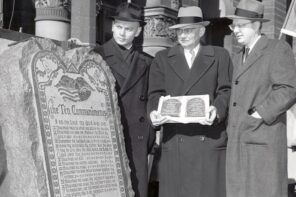“Oh, so you’re one of those sodomites. You should only get AIDS and die, you pig.”
—Michael Savage (Michael Alan Weiner)
The most infamous Biblical example of homosexuality—the story of Sodom—was never understood to be about homosexuality at all. Indeed, not only was the “sin of Sodom” understood in biblical texts to be ethical rather than sexual, but the association between the Sodom story and homosexuality only began around the 6th century, while the very term “sodomy” was coined in the 11th century as a legal classification for specific sins of Catholic priests.
Like the word “abomination,” which I recently wrote about for RD, progressives should stop using the term “sodomy,” because it feeds into the anti-gay, and ultimately anti-religious, myth that the Bible condemns homosexuality; the myth I call “God versus gay.”
Most of us know the story, told in Genesis 19, fairly well. God is preparing to destroy the cities of Sodom and Gomorrah, but will spare them if ten righteous people are found. Two angels (in the form of men) come to Sodom, and Lot meets them at the gates of the city, inviting them to stay with him overnight. They reluctantly do so, and Lot makes them a feast. “But before they lay down,” Genesis 19 continues, the men of the city surround Lot’s house and demand that Lot “bring them out to us and we will know them”—clearly understood sexually.
Lot goes out and begs them, “please, my brothers, do not do evil,” and offers his own virgin daughters in place of the men. They refuse, saying “we will execute judgment on the one who has come to stay [with you], and now we’ll do worse to you than them.” They press Lot back against the door, and are on the verge of breaking through the door when the angels grab Lot, pull him inside, and smite the men of Sodom with blindness. Quickly, the angels help Lot’s family escape, and Sodom and Gomorrah are destroyed by fire and brimstone.
Sodom is about Homosexuality Like an Axe Murder is about the Axe
As we will see, the Hebrew Bible almost univocally understands the sin the Sodomites committed in terms of ethics, not sexual morality. But even before turning to those texts, if we were to read the story of Sodom with fresh eyes, it’s obvious that homosexual rape is the means, not the end, of Sodom’s wickedness. Genesis 19 clearly contrasts Lot, who goes above and beyond the requirements of hospitality, with the Sodomites, who do the reverse. Lot insists that strangers dine and rest with him; the Sodomites seek to humiliate them.
This emphasis on hospitality is entirely of a piece with what we know of the Ancient Near East where, like today, among Bedouin and Arabs, hospitality is a core value. The Ancient Near East had no Holiday Inns; hospitality is essential for survival and its presence or absence says much about the ethical character of people. Consider Exodus 22:21 and 23:9 and its injunction not to oppress strangers; Luke 7:44-46 (where Jesus rebukes Simon: “I entered your house, you gave me no water for my feet… You gave me no kiss… My head with oil you did not anoint.”); Hebrews 13:2 (“Be not forgetful to entertain strangers: for thereby some have entertained angels unawares”); and Romans 12:13 (Christians should be “given to hospitality”). Treating guests properly is of paramount concern for both the Hebrew and Christian Bibles.
Moreover, the story of Sodom is in a biblical section where hospitality and ethics are central themes. Only one chapter earlier, Abraham had welcomed three men to his tent, and the text spends five verses on the details of the menu he prepares. (Indeed, after departing, these men “look toward Sodom,” suggesting they may be the same messengers—the Hebrew word malachim is less supernatural than “angels”—as appear in the next chapter.)
Right after Abraham’s bargaining with God on behalf of Sodom comes the well-known Sodom story and its aftermath, followed by yet another story of hospitality—this time of Abraham and Sarah’s visit to Gerar, where Abraham, fearing that king Abimelech will kill him in order to obtain Sarah, tells the king that Sarah is his sister. This entire section of Genesis is about variations of hospitality: Abraham’s and Lot’s generosity, the wickedness of Sodom, and Abraham’s fear that Gerar would act similarly. The men of Sodom’s interest in men is incidental; if they were raging homosexuals, Lot would not offer his daughters in return. Homosexual rape is the way in which they violate hospitality, not the essence of their transgression. Reading the story Sodom as being about homosexuality is like reading the story of an axe-murderer and saying it’s about an axe.
Other texts of the Hebrew Bible bear this out. Most clearly, Ezekiel 16:49-50 specifically defines the sin of Sodom. “Behold,” the prophet writes in God’s voice, “this was the iniquity of your sister Sodom: pride, fullness of bread, and abundance of idleness was in her and in her daughters, neither did she strengthen the hand of the poor and needy. And they were haughty, and did toevah before me, and I took them away as I saw fit.”
Now, if we assume that “toevah” here refers to the specific “toevah” of Leviticus 18 and 20 (as discussed in a previous article), and not to the other 101 times the term is used in the Bible, then male anal sex is one of the six sins of Sodom. It is, at most, no more central to “sodomy” than are pride, gluttony, sloth, and economic injustice.
But of course even this is a wild stretch of interpretation that stems not from the text but from our own pre-conceived notions of it. “Toevah” is used 39 times in the book of Ezekiel; 29 times it refers to idolatry and other foreign cultic/ritual acts; five times Ezekiel mentions it in connection with both “whoredom” (znut or zimah, both used elsewhere in the Bible to refer to female prostitution) and idolatry (avodah zara); twice it refers to heterosexual adultery; once to violence; and once to usury. Ezekiel never once mentions, alludes to, or even hints at homosexuality.
So, to read homosexuality into the description of Sodom’s sin—when Ezekiel uses the word toevah 39 times, never once in reference to homosexuality, and when he lists five specific injustices as the “sin of Sodom”—has absolutely no basis in the text. Indeed, given how “strengthening the hand of the poor and needy” is regarded as socialist anathema by today’s Tea Party zealots, the Tea Party has more in common with the Sodomites than do gays or lesbians.
Likewise in text after text after text, Sodom’s wickedness is connected to cruelty, injustice, and deceit—never homosexuality. Jeremiah 23:14:
I have seen also in the prophets of Jerusalem a horrible thing: they commit adultery, and walk in lies: they strengthen also the hands of evildoers, that none returns from his wickedness: they are all of them unto me as Sodom, and the inhabitants thereof as Gomorrah.
Amos 4:1-11:
Hear this word, children of Bashan, that are in the mountain of Samaria, which oppress the poor, which crush the needy, which say to their masters, Bring, and let us drink. I have overthrown some of you, as God overthrew Sodom and Gomorrah.
Over and over again, Sodom is linked with oppression of the poor, crushing the needy, and ethical wickedness—never sexual immorality.
Indeed, in the “echo” of the Sodom story in the Book of Judges, a woman is substituted for the desired men, and the crowd rapes her instead. That story, in Judges 19, is of a Levite traveling with his concubine, and staying at a house in Gibeah. As in the story of Sodom, the Levite is threatened by a Benjaminite mob that wants to “know him.” His host offers his own daughter, the mob refuses, and finally the Levite hands over his concubine to the mob, who raped and “abused her” all night long.
This horrible story, which concludes with the Levite killing and dismembering the concubine, is meant to tell of the degradation of Israel prior to the institution of the monarchy. But in mirroring the story of Sodom, it also tells us that it is not the gender of the angels or the Levite that matters to the mob; it is the use of sexual violence to degrade and humiliate. The Benjaminites are neither “gay” nor “straight,” and neither are the Sodomites. Both are predators, humiliators, dehumanizers.
Deuteronomy 32, consisting of Moses’ dire prophetic warning to the elders of Israel, includes a condemnation that Israel’s “vine is of the vine of Sodom, and of the fields of Gomorrah: their grapes are grapes of gall, their clusters are bitter.” (Deut 32:32) As with Ezekiel, a litany of sins is listed, but here idolatry is predominant, and again connected with toevah: “They provoked God with foreign [gods], angered Him with toevot. They sacrificed to demons (shedim), not to my God; to new gods they did not know, that your fathers did not fear.” (Deut. 32:16-18)
Moses predicts that God will say: “I will hide my face from them, and I will see what their end will be, because this generation is a contrary one, of faithless children. They provoked Me with godlessness, angered me with their vanities—and so I will provoke them with nationlessness and anger them with a foolish nation.” (Deut. 32:20-21) The theme and the structure of this passage is obvious: as Israel deserts God for idolatrous gods empty of substance (hevel, the same word from Ecclesiastes), so too God will desert Israel and displace it with other nations. Just as Israel turned away from God to serve other gods, so God will turn away from Israel.
Needless to say, there is not the slightest hint of sexual misconduct anywhere in this passage. Toevah sits in verse 16 in exact parallel to hevel (emptiness, vanity) in verse 21, and the entire passage is about Israel’s faithlessness in serving other gods, and God’s jealous rage in return. Once again, sodomy has nothing to do with homosexuality.
Sodom and Gomorrah are mentioned time and again in the Hebrew Bible and New Testament, but usually only as placeholders for wickedness in general (Isa. 1:9-10 [quoted in Rom. 9:29], Isa. 3:9, 2 Peter 2:6) or for evidence of God’s divine wrath (Isa. 13:19, Jer. 49:18, Jer. 50:40, Lam. 4:6, Amos 4:11, Zeph. 2:9, Matt. 10:15, Matt. 11:23-24, Luke 10:12), or the suddenness of Divine punishment (Luke 17:29). In the gospels, Jesus mentions Sodom as an example of divine punishment. Had “Sodom” been about homosexuality, would he not have even mentioned that fact, even in passing?
Indeed, the sole biblical reference to sexual immorality as connected with Sodom comes in the short epistle of Jude, and even there, the reference is to licentiousness generally and not homosexuality specifically. Jude, writing against “ungodly people, who pervert the grace of our God into a license for immorality and deny Jesus Christ our only Sovereign and Lord,” recites several examples of Divine punishment, and then: “In a similar way, Sodom and Gomorrah and the surrounding towns gave themselves up to sexual immorality and perversion. They serve as an example of those who suffer the punishment of eternal fire.” (Jude 1:7)
That’s it. And since Jude’s homiletical purpose is to preach against contemporary antinomians, he obviously is not talking about homosexuality, but rather the view of some heretics that the coming of Christ had obviated the need to obey the law in general. To twist this sole linkage of Sodom and immorality into some blanket condemnation of homosexuality is, at best, facetious.
Classical Jewish sources follow suit. The Babylonian Talmud, for example, associates Sodom with pride, envy, cruelty to orphans, theft, murder, and injustice (BT Sanhedrin 109a). And, as collected by Rabbi Steven Greenberg in his landmark book on Judaism and homosexuality, Wrestling with God and Men, there are many Jewish legends of Sodom that depict it as an extraordinarily rich, stingy, and cruel city. See, e.g., Genesis Rabbah 42, 49; Leviticus Rabbah 5, Numbers Rabbah 9. Indeed, as Greenberg notes, only a single classical Jewish text, the Avot de-Rabbi Nathan, links Sodom with homosexuality, and then only in one of the two extant editions of it. All the rest discuss Sodom, at length, but never make the association.
From Bad Neighbor to Sexual Sin, an Evolution
Where, then, does the common usage come from? The evolution is gradual. Catholic scholar Mark Jordan, in his exhaustive book The Invention of Sodomy, shows that the term “sodomy” (sodomia) originated in the eleventh century as a new classification of certain clerical sins by theologian Peter Damian. But the general association goes back further. The thinking of the early Church fathers echoed their rabbinic contemporaries. Origen, for example, associates sodomy with inhospitality.
But over the centuries, the association shifted, for reasons which remain unclear. St. Jerome identifies the sins of Sodom with pride and decadence—although Jordan notes one reference (in response to a question about dissolving a marriage) to a “Sodomite” having sinned sexually. St. Ambrose says that Sodom’s chief sins were luxury (luxuria) and lust (libido). By the time of St. Augustine, the sin had migrated to “debaucheries in men” (stupra in masulos), an association borne out by contemporary poetry and legend.
We do not know exactly why this evolution took place. Certainly, Augustine himself had a particular antipathy toward homosexuality, which is expressed in numerous condemnations far out of proportion to any antecedent in Western religious history. And as Christianity moved from the Near East into Roman contexts where homosexuality and pederasty were widespread, it makes sense that Church authorities would become increasingly concerned by it. By the 11th century, Jordan shows, the unclassified sin of sex with men became merged with luxuria (luxury, decadence, oversensuality) and deliberately constructed as “sodomy.”
Over time, of course, the term “sodomy” has come to be peculiarly polysemous; on the one hand it’s a special vice of homosexuals, while on the other it theoretically refers to any non-procreative sex, thus applying to many more straights than gays. (Indeed, to more teenagers: the latest surveys show that 55% of teens have had oral sex, including over 87% of non-virgins.) Then again, in America, these “neutral” sodomy laws were almost always prosecuted against gays only, and since the medieval period there has never been any doubt as to who the real Sodomites are, notwithstanding the broader definition.
Jordan goes further, arguing persuasively that the way sodomia was defined has permanently colored how we conceive of sexuality. Sodomy is defined by genitalia and orifices, and so we tend to define someone as “homosexual” or “heterosexual” by the combination of them. Other cultures, however, have defined sexuality differently. For example, until the 20th century (and even, in some places, until today) most Islamic cultures defined sexuality not anatomically, but according to role. “Active,” that is insertive, men were considered “straight” even if they were penetrating a boy or a man. “Passive,” receptive men were stigmatized—but not because they were “gay” but because they were “womanly.” Jordan’s compelling suggestion is that even the term “homosexuality” owes its constitution to the term “sodomy.”
Now, Christians who regard Augustine (and Aquinas, and subsequent theologians) as canonical are perfectly justified in equating “sodomy” with homosexuality, or at least homosexual behavior. But it should be quite clear that:
- The Bible never links the story of Sodom with homosexuality. To use the Sodom story as evidence that the Bible condemns homosexuality is totally inaccurate. It is an anachronism, projecting later Church interpretation onto the Biblical text, which is essentially about hospitality.
- Even understanding Sodom simply in terms of lust is a later interpretation. Biblical sources, and the story itself, uniformly show that again, the story is about hospitality, cruelty, and so on.
- Even if the story were about lust, it is about rape, not homosexuality. The Sodomites were not “gay.” They were rapists. This is why Lot could offer his daughters in replacement, why the Judges version of the tale actually has a female substitute, and why those few Biblical references to Sodom as being sexually-related speak in general terms rather than specific ones.
As with “toevah,” which means not “abomination” but “taboo,” the term “sodomy” is unfit for civil discourse. As Jordan notes, “the category ‘Sodomy’ cannot be used for serious thinking,” because it was constructed precisely to demarcate boundaries of sin—clerical sin at that—and not as any stable description of human behavior. The Bible condemns many things in the story of Sodom, but homosexuality is not one of them.
—-
For further reading, see Ed Noort and Eibert Tigchelaar, eds., Sodom’s Sin: Genesis 18-19 and its Interpretations (2004); Michael Carden, Sodomy: A History of a Christian Biblical Myth (Equinox, 2005); J. Harold Ellens, Sex in the Bible: A New Consideration (2006); Daniel Helminiak, What the Bible Really Says About Homosexuality 43-50 (2000 ed.). But see Wold, supra, at 77-89 (maintaining that the sin of Sodom was homosexual intercourse, not wishing to rape Lot’s guests).




